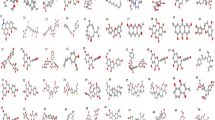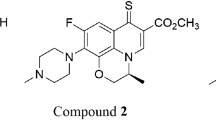Abstract
Streptomyces genus are filamentous Gram positive bacteria, of great intrest, producing biologically active compounds. Recent market and consumer curiosity in natural products have forced scientist and industry for the development of new products with therapeutic potential. This study focuses on evaluation of antioxidant and anticancerous properties of prodigiosin from radio-resistant Streptomyces sp. strain WMA-LM31. A molecular docking approach was adopted to understand theoretical binding mechanism and affinity for anticancer targets. A radio-resistant bacterium, labelled as strain WMA-LM31, was isolated from desert soil and screened for its radio-resistant potential and prodigiosin production. 16S rRNA gene sequencing showed that the bacterium clusters to genus Streptomyces and found resistant to ultraviolet radiation (dosage of 2 × 103 J/m2). Strain WMA-LM31 produced a red color pigment in tryptone glucose yeast (TGY) medium.The LC–MS analysis of the purified compound showed a molar mass of 324 [m/z]+ matched the chemical formula C20H25N3O, identified as prodigiosin. The compound showed strong antioxidant (62.51%) activities along with significant inhibitory action against oxidative damages to bovine serum albumin (BSA) and mice liver lipids in comparison to standard ascorbic acid. IC50 values of HepG2 and HeLa cell lines was found at 12.66 and 14.83 µg/mL of prodigiosin concentration, respectively. Furthermore, molecular docking was performed with two different cancers macromolecular targets: [2O2F (Bcl-2) and 1DI8 (CDK-2)], and BSA (PDB id: 3V03). The results indicated that the binding affinity of prodigiosin to its target molecules is due to the presence of terminal pyrrole rings. It is concluded from the results that prodigiosin from Streptomyces sp. strain WMA-LM31 has strong antioxidant, anticancer and apoptotic properties. The knowledge of binding mechanisms and interactions of prodigiosin could provide future directions in designing potent target specifc drugs.







Similar content being viewed by others
References
Brash DE (2015) UV signature mutations. Photochem Photobiol 91:15–26
Singh O, Gabani P (2011) Extremophiles: radiation resistance microbial reserves and therapeutic implications. J Appl Microbiol 110:851–861
Pfeifer GP (1997) Formation and processing of UV photoproducts: effects of DNA sequence and chromatin environment. Photochem Photobiol 65:270–283
Agar NS, Halliday GM, Barnetson RS, Ananthaswamy HN, Wheeler M, Jones AM (2004) The basal layer in human squamous tumors harbors more UVA than UVB fingerprint mutations: a role for UVA in human skin carcinogenesis. Proc Natl Acad Sci USA 101:4954–4959
Daly MJ, Gaidamakova EK, Matrosova VY, Kiang JG, Fukumoto R, Lee D-Y, Wehr NB, Viteri GA, Berlett BS, Levine RL (2010) Small-molecule antioxidant proteome-shields in Deinococcus radiodurans. PloS ONE 5:e12570
Delpech R (2000) The importance of red pigments to plant life: experiments with anthocyanins. J Biol Educ 34:206–210
Giri AV, Anandkumar N, Muthukumaran G, Pennathur G (2004) A novel medium for the enhanced cell growth and production of prodigiosin from Serratia marcescens isolated from soil. BMC Microbiology 4:11
Song M-J, Bae J, Lee D-S, Kim C-H, Kim J-S, Kim S-W, Hong S-I (2006) Purification and characterization of prodigiosin produced by integrated bioreactor from Serratia sp. KH-95. J Biosci Bioeng 101:157–161
Bartlett WT, O’Donovan GA, Neff RD (1970) Effect of gamma radiation on Serratia marcescens. Studies on the radiosensitivity of prodigiosin production. Radiat Res 43:196–203
Borić M, Danevčič T, Stopar D (2011) Prodigiosin from Vibrio sp. DSM 14379; a new UV-protective pigment. Microb Ecol 62:528
Montaner B, Pérez-Tomás R (2001) Prodigiosin-induced apoptosis in human colon cancer cells. Life Sci 68:2025–2036
Soto-Cerrato V, Llagostera E, Montaner B, Scheffer GL, Perez-Tomas R (2004) Mitochondria-mediated apoptosis operating irrespective of multidrug resistance in breast cancer cells by the anticancer agent prodigiosin. Biochem Pharmacol 68:1345–1352
Lee JS, Kim Y-S, Park S, Kim J, Kang S-J, Lee M-H, Ryu S, Choi JM, Oh T-K, Yoon J-H (2011) Exceptional production of both prodigiosin and cycloprodigiosin as major metabolic constituents by a novel marine bacterium, Zooshikella rubidus S1-1. Appl Environ Microbiol 77:4967–4973
Park H, Lee S, Kim T, Han S, Yim J (2012) Selection of extraction solvent and temperature effect on stability of the algicidal agent prodigiosin. Biotechnol Bioprocess Eng 17:1232–1237
Sajjad W, Ahmad M, Khan S, Ilyas S, Hasan F, Celik C, McPhail K, Shah AA (2017) Radio-protective and antioxidative activities of astaxanthin from newly isolated radio-resistant bacterium Deinococcus sp. strain WMA-LM9. Ann Microbiol 67:1–13
Mattimore V, Battista JR (1996) Radioresistance of Deinococcus radiodurans: functions necessary to survive ionizing radiation are also necessary to survive prolonged desiccation. J Bacteriol 178:633–637
Murray R, Costilow RN, Nester E, Wood W, Krieg N, Phillips G (1981) Manual of methods for general bacteriology. American Society for Microbiology, Washington, DC
Tamura K, Stecher G, Peterson D, Filipski A, Kumar S (2013) MEGA6: molecular evolutionary genetics analysis version 6.0. Mol Biol Evol 30:2725–2729
Gerber NN, Lechevalier M (1976) Prodiginine (prodigiosin-like) pigments from Streptomyces and other aerobic Actinomycetes. Can J Microbiol 22:658–667
Mekhael R, Yousif S (2009) The role of red pigment produced by Serratia marcescens as antibacterial and plasmid curing agent. J Duhok Univ 12:268–274
Nakashima T, Kurachi M, Kato Y, Yamaguchi K, Oda T (2005) Characterization of bacterium isolated from the sediment at coastal area of Omura bay in Japan and several biological activities of pigment produced by this isolate. Microbiol Immunol 49:407–415
Nakashima T, Miyazaki Y, Matsuyama Y, Muraoka W, Yamaguchi K, Oda T (2006) Producing mechanism of an algicidal compound against red tide phytoplankton in a marine bacterium γ-proteobacterium. Appl Microbiol Biotechnol 73:684–690
Lynch D, Worthy T, Kresheck G (1968) Chromatographic separation of the pigment fractions from a Serratia marcescens strain. Appl Microbiol 16:13–20
Xu J, Chen S, Hu Q (2005) Antioxidant activity of brown pigment and extracts from black sesame seed (Sesamum indicum L.). Food Chem 91:79–83
Ohkawa H, Ohishi N, Yagi K (1979) Assay for lipid peroxides in animal tissues by thiobarbituric acid reaction. Anal Biochem 95:351–358
Tian B, Sun Z, Shen S, Wang H, Jiao J, Wang L, Hu Y, Hua Y (2009) Effects of carotenoids from Deinococcus radiodurans on protein oxidation. Lett Appl Microbiol 49:689–694
Mosmann T (1983) Rapid colorimetric assay for cellular growth and survival: application to proliferation and cytotoxicity assays. J Immunol Methods 65:55–63
Bruncko M, Oost TK, Belli BA, Ding H, Joseph MK, Kunzer A, Martineau D, McClellan WJ, Mitten M, Ng S-C (2007) Studies leading to potent, dual inhibitors of Bcl-2 and Bcl-xL. J Med Chem 50:641–662
Shewchuk L, Hassell A, Wisely B, Rocque W, Holmes W, Veal J, Kuyper LF (2000) Binding mode of the 4-anilinoquinazoline class of protein kinase inhibitor: X-ray crystallographic studies of 4-anilinoquinazolines bound to cyclin-dependent kinase 2 and p38 kinase. J Med Chem 43:133–138
Majorek KA, Porebski PJ, Dayal A, Zimmerman MD, Jablonska K, Stewart AJ, Chruszcz M, Minor W (2012) Structural and immunologic characterization of bovine, horse, and rabbit serum albumins. Mol Immunol 52:174–182
Bernstein FC, Koetzle TF, Williams GJ, Meyer EF, Brice MD, Rodgers JR, Kennard O, Shimanouchi T, Tasumi M (1977) The Protein Data Bank: a computer-based archival file for macromolecular structures. J Mol Biol 112:535–542
Ahmad S, Raza S, Uddin R, Azam SS (2017) Binding mode analysis, dynamic simulation and binding free energy calculations of the MurF ligase from Acinetobacter baumannii. J Mol Graph Model 77:72–85
Mills N (2006) ChemDraw Ultra 10.0 CambridgeSoft, 100 CambridgePark Drive, Cambridge, MA 02140. http://www.cambridgesoft.com/. Commercial Price: 1910fordownload, 2150 for CD-ROM; Academic Price: 710fordownload, 800 for CD-ROM. ACS Publications, Boston
Jones G, Willett P, Glen RC, Leach AR, Taylor R (1997) Development and validation of a genetic algorithm for flexible docking. J Mol Biol 267:727–748
Case DA, Cheatham TE, Darden T, Gohlke H, Luo R, Merz KM, Onufriev A, Simmerling C, Wang B, Woods RJ (2005) The Amber biomolecular simulation programs. J Comput Chem 26:1668–1688
Paterlini MG, Ferguson DM (1998) Constant temperature simulations using the Langevin equation with velocity Verlet integration. Chem Phys 236:243–252
Roe DR, Cheatham TE III, (2013) PTRAJ and CPPTRAJ: software for processing and analysis of molecular dynamics trajectory data. J Chem Theory Comput 9:3084–3095
White O, Eisen JA, Heidelberg JF, Hickey EK, Peterson JD, Dodson RJ, Haft DH, Gwinn ML, Nelson WC, Richardson DL (1999) Genome sequence of the radioresistant bacterium Deinococcus radiodurans R1. Science 286:1571–1577
El-Bialy HA, El-Nour SAA (2015) Physical and chemical stress on Serratia marcescens and studies on prodigiosin pigment production. Ann Microbiol 65:59–68
Mandal S, Rath J (2014) Extremophilic cyanobacteria for novel drug development. Springer, Berlin
Beblo-Vranesevic K, Galinski EA, Rachel R, Huber H, Rettberg P (2017) Influence of osmotic stress on desiccation and irradiation tolerance of (hyper)-thermophilic microorganisms. Arch Microbiol 199:17–28
Ferroni L, Klisch M, Pancaldi S, Häder D-P (2010) Complementary UV-absorption of mycosporine-like amino acids and scytonemin is responsible for the UV-insensitivity of photosynthesis in Nostoc flagelliforme. Mar Drugs 8:106–121
Gulani C, Bhattacharya S, Das A (2012) Assessment of process parameters influencing the enhanced production of prodigiosin from Serratia marcescens and evaluation of its antimicrobial, antioxidant and dyeing potentials. Malays J Microbiol 8:116–122
Imlay JA (2003) Pathways of oxidative damage. Ann Rev Microbiol 57:395–418
Ferrer M, Golyshina O, Beloqui A, Golyshin PN (2007) Mining enzymes from extreme environments. Curr Opin Microbiol 10:207–214
Gostinčar C, Grube M, De Hoog S, Zalar P, Gunde-Cimerman N (2009) Extremotolerance in fungi: evolution on the edge. FEMS Microbiol Ecol 71:2–11
Fiedor J, Burda K (2014) Potential role of carotenoids as antioxidants in human health and disease. Nutrients 6:466–488
Girotti AW (1998) Lipid hydroperoxide generation, turnover, and effector action in biological systems. J Lipid Res 39:1529–1542
Asleh R, Guetta J, Kalet-Litman S, Miller-Lotan R, Levy AP (2005) Haptoglobin genotype–and diabetes-dependent differences in iron-mediated oxidative stress in vitro and in vivo. Circ Res 96:435–441
Mukherjee T, Bose S, Mukhopadhyay SK (2017) Antioxidant properties of the carotenoid extracts of three Deinococcus–Thermus phylum bacteria, Meiothermus sp. strains RP and TP and Thermus sp. strain YY from Paniphala hot spring, India. Nutrire 42:7
Manderville R (2001) Synthesis, proton-affinity and anti-cancer properties of the prodigiosin-group natural products. Curr Med Chem-Anti-Cancer Agents 1:195–218
Williamson NR, Fineran PC, Gristwood T, Chawrai SR, Leeper FJ, Salmond GP (2007) Anticancer and immunosuppressive properties of bacterial prodiginines. Future Med. https://doi.org/10.2217/17460913.2.6.605
Llagostera E, Soto-Cerrato V, Joshi R, Montaner B, Gimenez-Bonafé P, Pérez-Tomás R (2005) High cytotoxic sensitivity of the human small cell lung doxorubicin-resistant carcinoma (GLC4/ADR) cell line to prodigiosin through apoptosis activation. Anti-Cancer Drugs 16:393–399
Darshan N, Manonmani H (2015) Prodigiosin and its potential applications. J Food Sci Tech 52:5393–5407
Acknowledgements
This work was supported by grants from Higher Education Commission of Pakistan under International Research Support Initiative Program (IRSIP). We also highly acknowledge McPhail Lab, Department of Pharmaceutical Sciences, Oregon State University, USA, for providing the opportunity to work in collaboration. We also acknowledge the contribution of Biochemistry Laboratory, Quaid-I-Azam University Islamabad, Pakistan by providing equipment facilities in bioassay studies.
Author information
Authors and Affiliations
Corresponding author
Ethics declarations
Conflict of interest
All the authors declare no conflict of interest associated with this work.
Ethical approval
This article does not contain any studies with human or animals participants, performed by any of the authors.
Rights and permissions
About this article
Cite this article
Sajjad, W., Ahmad, S., Aziz, I. et al. Antiproliferative, antioxidant and binding mechanism analysis of prodigiosin from newly isolated radio-resistant Streptomyces sp. strain WMA-LM31. Mol Biol Rep 45, 1787–1798 (2018). https://doi.org/10.1007/s11033-018-4324-3
Received:
Accepted:
Published:
Issue Date:
DOI: https://doi.org/10.1007/s11033-018-4324-3




